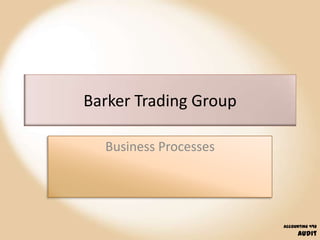Barker trading group
- 1. Barker Trading Group Business Processes Accounting 492 Audit
- 2. Organization Chart Board of Directors Director (Terry) BTCM (Class Student Wells Fargo Dan 550 Foundation Account) Accounts Accounting 492 Audit
- 3. Business Process â Class Account Investment Portfolio Committees Financial Officer reviewed suggest Transactions reports executes and investment/ recorded by based on trades on balanced by class brokerage brokerage Think or Director and approves reports Swim Risk Officer Accounting 492 Audit
- 4. Business Process â Individual accounts Portfolios Financial Investment reviewed Trader Transactions reports parameters and executes recorded by based on set by balanced by trades brokerage brokerage director director and reports risk officer Accounting 492 Audit
- 5. Business Process â Operating costs Disbursements Budget Dean is Expenses authorized by approved by signatory on submitted to Deanâs Board of checking Deanâs office assistant based Directors account on budget Accounting 492 Audit
- 6. Transfer of funds Investors Legal 11,374 36,426 Fees Wells Fargo 30,000 Foundation 68,834 19,962 Seminar 23,000 20,512 Trading 5,700 Accounts (15) Dan 550 424,491 (5,682) 24,056 Operational Expenses Accounting 492 Audit
- 7. What you need to do âĒ Understand for investing and cash each â Account â Business Process (initiate, authorize, process, record, report) âĒ Understand internal controls at entity and transaction level âĒ Assess inherent risk, control risk, and detection risk at assertion level âĒ Design tests of controls (nature and extent) âĒ Design substantive tests (nature and extent) âĒ Use a logical organization for your workpapers Accounting 492 Audit






